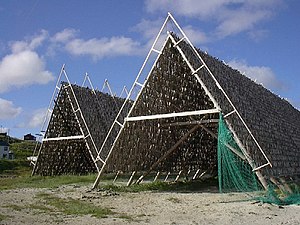


Stockfish is unsalted fish, especially cod, dried by cold air and wind on wooden racks (which are called "hjell" in Norway) on the foreshore. The drying of food is the world's oldest known preservation method, and dried fish has a storage life of several years. The method is cheap and effective in suitable climates; the work can be done by the fisherman and family, and the resulting product is easily transported to market.
Over the centuries, several variants of dried fish have evolved. The stockfish (fresh dried, not salted) category is often mistaken for the klippfisk, or salted cod, category where the fish is salted before drying. Salting was not economically feasible until the 17th century, when cheap salt from southern Europe became available to the maritime nations of northern Europe.
Stockfish is cured in a process called fermentation where cold-adapted bacteria matures the fish, similar to the maturing process of cheese.
In English legal records of the medieval period, stock fishmongers are differentiated from ordinary fishmongers when the occupation of a plaintiff or defendant is recorded.[1]
- ^ Plea Rolls of the Court of Common Pleas; Henry VI; in 1460; second entry, first line http://aalt.law.uh.edu/AALT1/H6/CP40no799/aCP40no799fronts/IMG_0704.htm